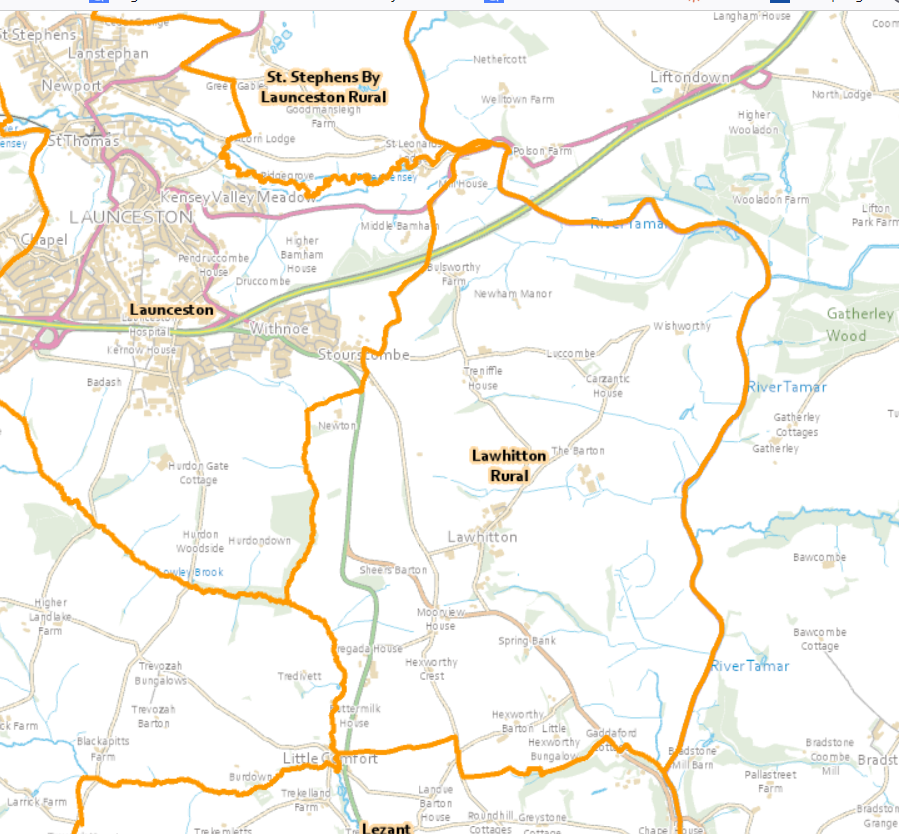
Lawhitton Parish Council meets on the third Tuesday every other month at the Village Hall at 7.30pm. Members of the public are welcome to attend and may address matters to the Council during the Public Session which is at the beginning of the meeting.
The Parish of Lawhitton is on Cornwall’s eastern boundary, roughly half way between north and south coasts, with the parishes of St Stephen by Launceston to the north, Launceston itself to the west, South Petherwin to the south west, and Lezant to the south. Its fairly long eastern boundary is with the River Tamar.
History
The parish has a long and distinguished history, being one of the earlier Cornish areas to be mentioned in historical documents. In 830 A.D. King Ecgberht of Wessex gave to the Bishop of Sherborne the estate of Landwithan and two other estates in what is now Cornwall – but was then, of course, the kingdom of Dumnonia. Landwithan at that time comprised what would become the parishes of Lawhitton, Lezant, South Petherwin (including Launceston) and Trewen. Quite how a king of Wessex was able to make such a grant is not entirely clear, but we do know that King Gereint of Cornwall had given estates to Sherborne Abbey about a century before, following a conciliatory approach by the Saxon Aldhelm (trying to persuade the Cornish clergy to adhere to the Roman traditions adopted at the Synod of Whitby), so perhaps he also gave this estate.
The property was transferred to the Bishops of Crediton when Sherborne’s diocese was split in 909, and then to the Bishops of Exeter in 1050, when Bishop Leofric decided that he wanted his cathedral there, and it remained as the Bishop’s Peculiar Deanery of Lawhitton until it was disbanded in 1850. The benefice originally consisted of a vicarage and sinecure rectory, but in 1261 they were consolidated, from which date the living was a rectory only. It had the dubious distinction, however, of being a convenient gift to Clerks of the Bishop’s household until something better should come along, so from 1260 to 1924 the parish had no fewer than 58 rectors, a number which (the late historian Charles Henderson comments) is about twice the number in most Cornish parishes, and of which only 19 were resident!
Naturally there is now no evidence of any place of worship earlier than the Norman Conquest, and even that era has only the base of the tower and the font as evidence. It seems likely that the Norman church consisted of chancel and nave, with a south transept culminating in the tower. But in the 15th century the transept was swept away and replaced with a south aisle (which is narrower than the chancel and nave), leaving the tower in an unusual, and unique, location – attached to the south aisle and partially absorbed by it. At that time a south porch was also added, and that is the church we see today, dedicated to St Michael, although it was the subject of restorations in 1860 and 1873.
The church is sited in the centre of the village, on the left hand side as you approach from the west. To the left of the lychgate (erected in 1890) is a large white walled building, now a dwelling, which was formerly the site of the Bishop’s residence – it is said that Bishop Robert Warelwast was resident there in 1153. And to the right of the gate is the parish War Memorial, in the form of a granite Celtic cross. Moving to the right a little, we get a complete view of the southern side of this compact little church and its interesting tower. Walking up the path from the lychgate, we come to the gabled 15th century porch, built of granite ashlar, inside which is a Tudor-arched inner doorway with a niche above – now empty, but no doubt formerly holding a statue of a saint – and a holy water stoup to the right of the doorway. The carved ribs, rafters and bosses are original.
Traffic latest:-
Highways how to find out where those pesky roadworks are:-
https://one.network/ click on this link and expand the page and it shows all the roadworks that are currently being carried out. Sadly it doesnt show any emergency roadworks.